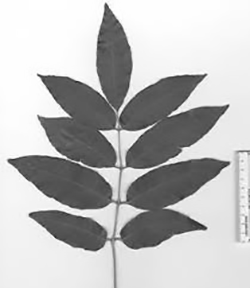
(above) Black Walnut, Hickory or Ash?
A positive identification is required before making any decision on your tree.
THE ASH TREE CATASTROPHE STRIKES NEW JERSEY
EMERALD ASH BORER (EAB)
Emerald ash borer (EAB) is a non-native insect pest from Asia that infests and kills all species of ash trees in North America. It was first discovered in southeastern Michigan in 2002 and EAB has since been found in 27 additional states and 2 Canadian providences. The EAB has killed tens of millions of ash trees in Michigan alone, as well as hundreds of millions of additional trees in the other infested states and providences.
The adult EAB is approximately 1/2” long and 1/8” wide, metallic green in color, with a metallic copper red abdomen. The larvae are white or cream colored, measure approximately 1 to 1 ¼” long and have 10 abdominal segments that are bell shaped. The EAB has a 1-year lifecycle.
EAB adults emerge in May or early June creating D-shaped exit holes, undetectable to most people, on the branches and trunks of infested trees. The female adult EAB feeds on the margins of the ash leaf. After feeding, the female EAB deposits eggs in bark crevices or under bark flaps on the trunk or bark. The adult beetle stays active until August. After the egg matures, larvae burrow under the bark and feed on the cambium – the water and nutrient transporting layer of the tree. The larvae become adult beetles in April or May. Then the cycle begins again.
EAB first infest the top of the tree’s crown, which makes spotting adult beetles or exit holes nearly impossible from the ground. Woodpecker activity and damage on live trees is often an initial symptom of an EAB infestation. As EAB populations increase, crown dieback, ideal branching, bark splits, and exit holes lower on the bole become more prevalent. Trees will only live an average of 3-4 years after infestation and 99% of ash trees will die.
WHAT SHOULD THE HOMEOWNER DO
The first thing a homeowner should do is to identify the trees on your property. There are other trees that look like Ash trees but are not affected by the EAB.
React now to save your tree with insecticide treatment or prepare financially to have it removed soon.
Treated trees must be re-injected every two or three years. Although treatment is expensive in some cases treatment may be less expensive than removal. The recommended timing for systemic treatment (injection) is in mid-May though June while leaves are leafing out.
Once infested with EAB the trees die quickly, usually within three years. The dead trees become very brittle making it a hazard to home owners as well as the tree company taking it down. Branches can snap and fall to the ground striking workers below.
For more information, including how to identify Ash trees go these following sources.
Contact your local cooperative extension.
In Union County call Rutgers Cooperative Extension Garden Helpline. 908-654-9852 or e-mail mastergardeners@ucnj.org
Call your hometown Department of Public Works. Especially if you believe it might be a street tree.
Contact a certified licensed “Tree Expert”. To detect damage, a professional certified tree expert is often required.
My advice is re-act now. As more trees die, Ash tree removal prices are likely to go up also.
Share this information with friends and neighbors.
Good luck & Happy summer,
James
*Thanks to www.emeraldashborer.nj.gov for much of the information in this article.
